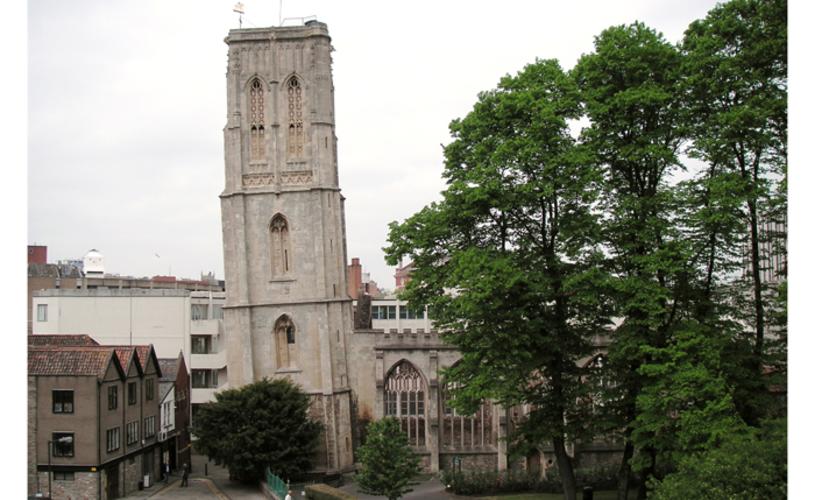It's easy to walk past Bristol's many magnificant churches and appreciate them just for their beauty, but these historic buildings have also built up centuries of stories and secrets.
Bristol-based author Charlie Revelle-Smith has curated the popular @WeirdBristol books and Instagram feed in which he documents the lesser-known and hidden history of the city. Here he gives us a tour through some of Bristol’s oldest churches and shares the strange secrets behind some of the city’s most iconic buildings.
St Mary Redcliffe
The current, gothic masterpiece which is St Mary Redcliffe church was completed in the 15th century and is regarded as one of the finest religious buildings of its age to be found in Britain.
Queen Elizabeth I, on her 1574 visit to Bristol is believed to have commented that it was “the fairest, goodliest and most famous parish church in England” – unfortunately Elizabeth almost certainly never said such a thing.
Two of the most remarkable remnants of the church’s history can be found not in the grand building itself but in the churchyard – both of which come from the 20th century.

Image - St Mary Redcliffe
On a bank of grass outside of the Priests’ Entrance to the church is a small stone plaque with a dedication to “Tom The Church Cat”. Tom was a tabby cat who was found scratching at the door to the church during a rainstorm in 1912 and soon became a resident of the church, chasing down mice and occasionally sitting near the altar during services. Tom was such a beloved member of the congregation that upon his death in 1927, he was given a full funeral service and buried in the ground close to where he had once been found.
Also in the churchyard is a perpendicular piece of tramway embedded in the grass. It was propelled to this spot by an enormous Luftwaffe bomb, which detonated in Redcliffe in 1940. The section of track was sent soaring over the row of nearby houses and was thrust into the ground like a javelin. It is now kept as a reminder not just of the losses suffered during WWII but also how close the church once came to total destruction.

Image - Tramway in the garden of St Mary Redcliffe
St Peter’s Church, Castle Park
The bombed out skeleton of St Peter’s Church in Castle Park is a haunting remnant of the Bristol Blitz and is a memorial to the 1,299 people killed during 77 air raids over the city.
The most devastating of these raids occurred on the night of the 24th of November, 1940. The area which is now Castle Park was a densely populated maze of streets and Tudor houses – many of which were made of wood. It was said that some of the streets were so narrow that it was possible to lean out of an upstairs window and shake hands with someone doing the same in a facing building.
The first sign that something was amiss over Bristol came when several people leaving pubs in the Old City spotted white lights falling from the sky. These were “fairy lights”, dropped by the first Luftwaffe planes to arrive over the city and were used to illuminate the targets for bombers who were close behind them.
Air raids sirens sounded only minutes before the first bombs fell and soon afterwards, the beautiful heart of the city was ablaze. The incendiary bombs which dropped were intended not to cause devastation by blasting away buildings but to incinerate them. Thousands of tons of bombs fell across Bristol but nowhere was damaged more than the area which is now Castle Park.
One of the most terrifying moments recalled by those who were first on the scene of the inferno was a curious, silvery river running down the street and into the harbour. They did not know at the time but this was the lead roof of St Peter’s Church, which had entirely melted due to the heat of the fire.
207 people died that night and the ruins of the church were left as a harrowing reminder of both the devastation that came to the city but also the resilience of the people of Bristol.
- Learn more about Bristol in WW2 on the St. Nicholas Market and Air Raid Shelter Walking Tour


Image - St Peters Church
Temple Church
Due to its dizzyingly wonky tower, Temple Church in Redcliffe is one of the most easily recognised churches in Bristol. In fact, the distinct lean on the bell tower has earned it the nickname “The Leaning Tower of Bristol” – as its slant is only a mere degree less than its more famous Pisa counterpart.
The church has its roots all the way back in the 12th century when a round structure was built on this ground as one of the earliest Knights Templar churches in the country, but the current structure was begun in the 1390s, with the bell tower finished about a century later. The tower began to lean midway through construction, probably because it was built upon soft, clay-rich soil.
The weirdest tale from the church’s history has to be the sensational 1778 exorcism of George Luskins. The tailor from Yatton had been exhibiting strange and worrying behaviour, such as singing and screaming in a strange tongue. After meeting with a local priest, it was declared that Luskins was possessed by no less than seven demons. Luskins was sent to Bristol where seven Methodist ministers performed the exorcism in Temple Church, under strict orders of secrecy.
However, curious locals eavesdropped on the curious event and soon word got out that the holy rite had been performed in the church. Luskins returned to Yatton soon afterwards and it is believed that he lived out the rest of his life untroubled by the demons which had once possessed him.

Image - Temple Church
All Saints’ Church
The narrow alleyways which surround the now disused All Saints Church in the Old City give some idea what the area would have been like in the many centuries before WWII, when the heart of the city was a labyrinth of passageways and winding streets.
This church is thought to be the oldest within what was the medieval, walled boundary of Bristol and as such, has been central to the history of the city for countless generations. The west nave dates back to the 11th century, but most of the current structure was built during the 15th century.
Due to Bristol being a port of international importance, the city fell victim to wave after wave of bubonic plague as sailors and their goods unwittingly came into port carrying the infection, which spread among the population at a terrifying rate. For three centuries, beginning in 1348 when the Black Death first struck. Between half and two-thirds of the city’s population may have died as the rampant infection took hold time and again.
At its peak, bodies were left piled high outside All Saints’ Church while the streets around it were fearfully abandoned for extended periods of time, so much so that long grass began growing through the cobbles, eventually covering all of the Old City.

Image - All Saints' Church
St Mary’s Church, Henbury
There has probably been a church of some sort at this spot since the 7th century but the current church was likely built sometime in the 13th century. However, the church’s greatest claim to fame is not the church itself, but two of the bodies interred in its graveyard.
One of the most distinct graves in Bristol marks the final resting place of novelist and Egyptologist Amelia Edwards (1831-1892). Edwards was a pioneer of travel writing and travelled extensively around Europe, often unaccompanied – a feat almost unheard of for a woman, but her true passion was for Egypt.
In her later years she campaigned tirelessly for the preservation of ancient Egyptian artefacts – which is why her grave features both an obelisk and an ankh. She is buried alongside her “friend and companion” Ellen Drew Braysher. This was so rare for the time that in 2016 it was officially listed by Historic England as a monument of significance to LGBT+ history.
Another striking grave in the churchyard is a stark reminder of a shameful chapter in Bristol’s history. Ornate head and footstones mark the grave of West African slave Scipio Africanus (1702-1720). Named after a Roman general, tragically little is known of his life aside from that he served the 7th Earl of Suffolk and died aged only 18. It is one of the few memorials in Britain known to have been dedicated to a slave.

Read more:





